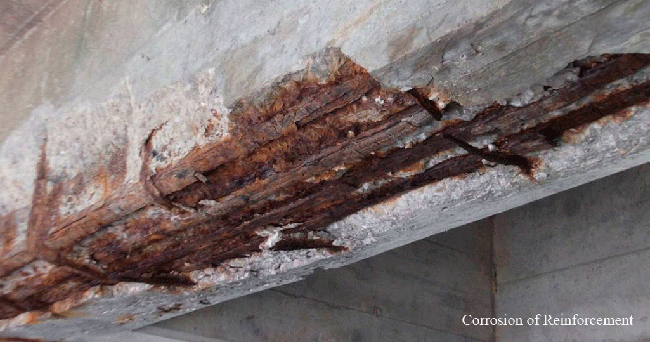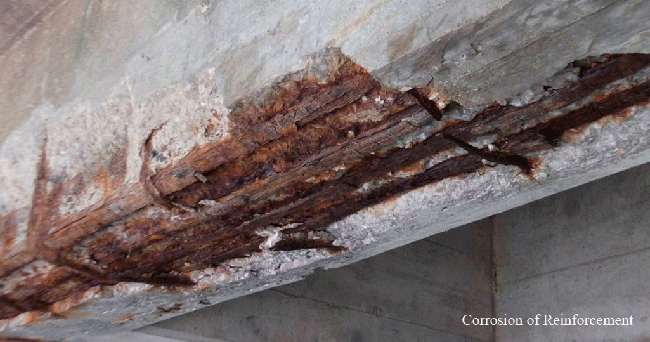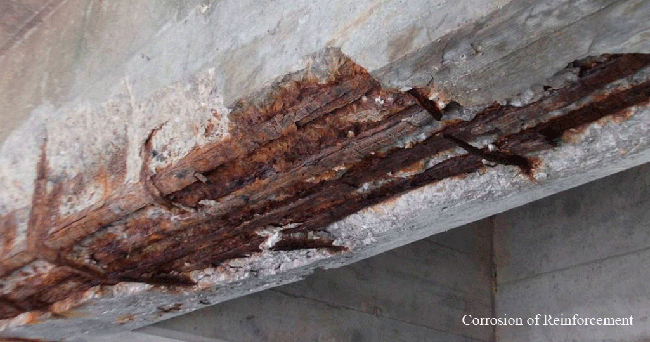Concrete deterioration is a permanent problem and affects the useful life of a structure. The deterioration of concrete has numerous consequences and can even lead to the collapse of structures.
Therefore, it is necessary to pay the greatest attention to the structure at the design stage, construction and during operation. Even if we build the structure with good technology and perfect design, lack of attention to the condition of the structure during its useful life can lead to its failure.
The durability of a structure depends on many factors. The most important factors that affect the durability of concrete or its aging are corrosion of reinforcement, chemical attack on concrete, reactivity of alkaline aggregates, abrasion/erosion, fire/heat, restriction of volume variation, overload, shock loads, loss of supports and surface. defects.
Let's briefly discuss each defect.
Reinforcement corrosion
Corrosion of reinforcement is directly related to the formation of cracks in concrete. Cracking in concrete exposes the reinforcement to a corrosive environment.
Reinforcement It starts corrosive due to the presence of oxygen and moisture. If we can avoid this, corrosion can be avoided . In Additive, There are other methods of Corrosion or Reinforcement as well. They are not that common.


Let's see what are the most common causes of reinforcement corrosion
Chloride attack
Chloride ions (CL-) are formed when substances such as hydrogen chloride are dissolved in water or when the element chlorine receives an electron. Chloride ions in high concentrations in concrete can cause serious problems. Due to their electrochemical nature, chloride ions dissolve the passive layer of steel reinforcement, eliminating the need to lower the pH value. Corrosion occurs when chloride ions interact with passive materials such as steel and the environment, triggering a chemical reaction that results in the formation of hydrochloric acid. Steel reinforcement is destroyed by hydrochloric acid, resulting in cracks. flaking and finally the failure of the concrete.
Concrete carbonation
Carbonation is the result of the reaction between calcium hydroxide in the cement paste and carbon dioxide in the air. This reaction produces calcium carbonate, which also lowers the pH to about 9. At this point, corrosion becomes a possibility as the protective oxide layer surrounding the reinforcing steel breaks down. Because carbon dioxide and calcium hydroxide can only react in solution, carbonation occurs slowly in dry concrete. In saturated concrete, moisture forms a barrier that prevents carbon dioxide from penetrating, so carbonation is also slow. When there is enough moisture to harden the concrete, carbonation is able to lower the temperature. Carbonation A reaction occurs, but it is not so strong as to create a barrier. This is the ideal situation.
Corrosion of different metals
When two different metals come into contact, an electrode potential is created that depends, among other things, on the two metals and the electrolyte present. In general, the higher the electrode potential or the further apart the two metals are in the series of electrochemical voltages, the more bimetallic corrosion will occur. However, electrode potential can vary due to the formation of oxide layers and cannot be used alone to predict whether and to what extent bimetallic corrosion will occur.
Freeze and thaw damage
Low temperatures cause the water trapped in the pores of the cement paste to freeze. Because ice takes up more space than water when it freezes, expansion forces can arise when the pores are almost completely filled with water or the concrete is saturated. If the expansion pressure caused by freezing exceeds the local strength of the concrete, damage will occur.
Cracks appear in any pattern on the concrete surface. Expansion pressure can cause deterioration or peeling of the surface to the depth that frost conditions have already reached. Freezing and thawing cycles cause increasingly extensive damage.
Defrosting Scale
Slag cement-based concrete generally has good strength and long-term durability. The thawing resistance of slag-containing concrete, particularly when the slag content exceeds 50% of the total cementitious material in the mix, has raised some concerns. Although there is evidence that these combinations often work well in practice, many of the concerns appear to be based on the results of laboratory slag deposition tests based on ASTM C 672.
Aggregate expansion
Some aggregates can absorb so much water that they cannot withstand the hydraulic pressure and expansion caused by freezing water. If there are enough problematic particles present, this can cause expansion of the aggregate and potentially disintegration of the concrete. Pop-out can occur when a problematic particle is close to the concrete surface.
Chemical attack
Concrete resists well different conditions of air, water, soil and various chemicals.
But even high-quality concrete can break under certain chemical conditions. To seriously attack concrete, aggressive chemicals must be present in the solution and in a certain minimum concentration.
acids
The acid resistance of Portland cement concrete is often low. In fact, no hydraulic cement concrete, regardless of its composition, will resist for long a solution with pH 3 or lower.
However, some mild acids can be tolerated with only occasional exposure. Portland cement concrete typically needs to be protected from acid with surface protection treatments to prevent deterioration caused by acid attack. Siliceous aggregates, unlike limestone and dolomite aggregates, are resistant to acids and are sometimes necessary to increase the chemical resistance of concrete, particularly when chemical-resistant cement is used. The reduced permeability of well-cured concrete makes it more resistant to acid attacks.
salts and bases
Concrete degradation is caused by chlorides and nitrates of ammonium, magnesium, aluminum and iron, with ammonium causing the greatest damage. Because they produce ammonia gas and hydrogen ions in the alkaline environment of concrete, most ammonium salts are harmful. Removing calcium hydroxide from concrete replenishes them. This results in a leaching reaction similar to an acid attack. Concrete deterioration can also be caused by strong alkalis (more than 20%).
Sulfate attack
There are cases when groundwater or soil contains natural sulfates of sodium, potassium, calcium or magnesium. Sulphates can damage concrete by reacting with hydrated cement components during curing. These reactions can create enough pressure to break the cement paste, which would reduce cohesion and strength. Ettringite is formed when calcium sulfate attacks calcium aluminate hydrate. Ettringite and gypsum are formed when sodium sulfate combines with calcium hydroxide and calcium aluminate hydrate. Ettringite, gypsum and brucite form when magnesium sulfate attacks in a similar way to sodium sulfate (magnesium hydroxide). Brucite forms on most of the concrete surface, consumes calcium hydroxide to lower the pH of the pore solution, and then decomposes calcium silicate hydrates.
Alkaline aggregate reactivity
Aggregates are generally chemically inert in concrete. However, some aggregates expand and crack over long periods of time when exposed to the alkaline hydroxides in concrete. Alkaline-silica reaction (ASR) and alkali-carbonate reaction are the two types of this alkali-aggregate reaction (ACR).


Reactivity to alkali silicate
As reactive silicate aggregates are widely used, alkali-silica reaction (ASR) is a major problem. In ASR, the alkaline hydroxide in concrete reacts with some types of silicate particles to form a gel that expands as it absorbs water from the surrounding cement paste or the environment. These gels can cause damage to concrete due to their expansion pressure.
The random formation of cracks and closed joints accompanied by concrete spalling are typical signs of ASR. Cracks typically occur in locations where moisture is regularly present, such as around water lines on piers, near the ground behind retaining walls, near joints and exposed edges in walkways, or in piers or columns that are susceptible to absorption. ASR can be identified with certainty through a petrographic survey.
Alkaline carbonate reactivity
ACR is a phenomenon that can be observed in certain dolomite rocks. Dedolomitization or decay of dolomite is generally associated with expansion. The brucite reaction and subsequent crystallization can result in significant growth. Alkali-carbonate reactions (ACR) are very rare because aggregates susceptible to this phenomenon are less common and are generally not suitable for use in concrete for other reasons. However, the degradation caused by ACR is identical to that caused by ASR. Petrographers can recognize the characteristic texture of ACR-susceptible aggregates. In contrast to the alkali-carbonate reaction, the introduction of additional ligands does not prevent the harmful expansion caused by ACR. It is recommended that concrete does not contain aggregates susceptible to ACR.
Abrasion/erosion
Abrasion and erosion are not common problems with concrete. They depend on the purpose of the concrete. On roads, parking lots, ramps, etc., abrasion can cause concrete to deteriorate.
Therefore, concrete abrasion often occurs on concrete exposed to traffic.
On the other hand, concrete erosion is mainly due to water movement. Water flowing constantly or frequently can cause concrete erosion. When water speed is high, concrete erosion can be greater.
Hydraulic structures such as spillways, channels, etc. can be observed. To reduce the abrasion/erosion of concrete, higher quality concrete is used.
Destruction of concrete by fire/heat
A fundamental building design requirement to ensure occupant safety is the implementation of adequate fire protection systems. One of the most destructive factors contributing to the deterioration of reinforced concrete structures is fire damage. Although concrete is a non-combustible material, it loses some of its physical, chemical and mechanical properties when exposed to high temperatures. The size and duration of the fire play an important role in determining the severity of a fire in concrete structures. Damage to concrete structures will likely be minor if the fire is moderate in size and lasts a short period of time. Likewise, a larger or prolonged event is likely to cause greater damage or collapse concrete buildings.


Cracking in concrete due to volume change restriction
Any material whose volume changes due to its inherent properties or due to environmental influences. Concrete also undergoes a volume variation between its initial stage and its useful life.
Due to the obstruction of volume change, two main types of cracks can be observed.
Shrinkage Crack Drying
The shrinkage of a hardened concrete mix as a result of capillary loss of water is known as drying shrinkage. Before the concrete is stressed, shrinkage increases the tensile stress, resulting in cracks, internal deformation and external deformation. As Portland cement concrete ages, it undergoes drying shrinkage or a change in hydrate volume. For the engineer designing a structure, the change in the volume of hydrate in the concrete is crucial. Slabs, beams, columns, structural walls, prestressed elements, tanks and foundations are all susceptible to dry shrinkage.
Shrinkage during drying is influenced by several variables. This includes component size, component properties, component proportions, mixing technique, moisture content during curing, and dry atmosphere. Normal curing conditions result in some volume change in the concrete. The main causes of shrinkage during drying are water in the cement paste and evaporation of capillary water. The effects of shrinkage during drying are more pronounced the more water is contained in the fresh concrete. The amount of mix, time since water was added, temperature fluctuations, sinking, placing and curing all affect how much concrete shrinks. The composition of the concrete is also crucial. Each type of cement and aggregate has unique properties, each affecting how much the concrete shrinks.
The shrinkage of concrete as it dries is influenced directly and indirectly by the amounts of water and additives used during mixing. The main cause of concrete shrinkage is the evaporation of capillary water used in the mixture. The size, location and temperature of the structure, as well as the physical properties of the concrete influence the severity of shrinkage.
Thermal cracking
Different parts of a concrete structure may lose heat to different degrees through hydration, or the climate may cool or heat one part of the building to a different degree or degrees than another part, which can result in temperature differences within the structure. Cracks are caused by the different volume changes caused by these temperature changes. This is usually related to mass concrete, such as: B. large, thicker parts of columns, pillars, beams, foundations and slabs. Any structure can be affected by a temperature difference caused by changes in ambient temperature.
Due to the release of heat during cement hydration, the center of the concrete may heat up more than the outside, or the outside may cool faster than the inside, depending on the cause of the temperature gradient. In both cases, tensile stresses occur on the outside and when the tensile strength is exceeded, cracks form. Tensile stresses are related to temperature differences, the coefficient of thermal expansion, the effective modulus of elasticity (which is reduced by creep) and the degree of restriction. The possibility of temperature differences and limitations increases with structural mass. The coefficient of thermal expansion of hardened concrete can vary between 4 and 9×10-6 per degree Fahrenheit.
The possibility of thermally induced cracks arises when an area of a structure undergoes a change in volume due to temperature. Structures where certain parts are exposed to temperature fluctuations while other parts are fully or partially protected must be designed with special care. The exposed element may crack due to the decrease in temperature, while the shielded part of the structure may crack due to the increase in temperature.
Surface defects
Defects in the concrete surface can lead to durability problems. They are also usually related to the problems discussed above. Uneven concrete surfaces can cause cracking due to their irregularities, unlike smooth surfaces.
Additionally, below are some issues that lead to concrete damage.
- honeycombs
- Unrepaired anchor holes
- Cold joints
- Shape shifts
- sand strip
- Forming strands
All defects mentioned above must be corrected during the construction phase. Some of them affect not only concrete wear but also structural stability. honeycombs , cold joints etc. These are structural deficiencies that we need to resolve.

